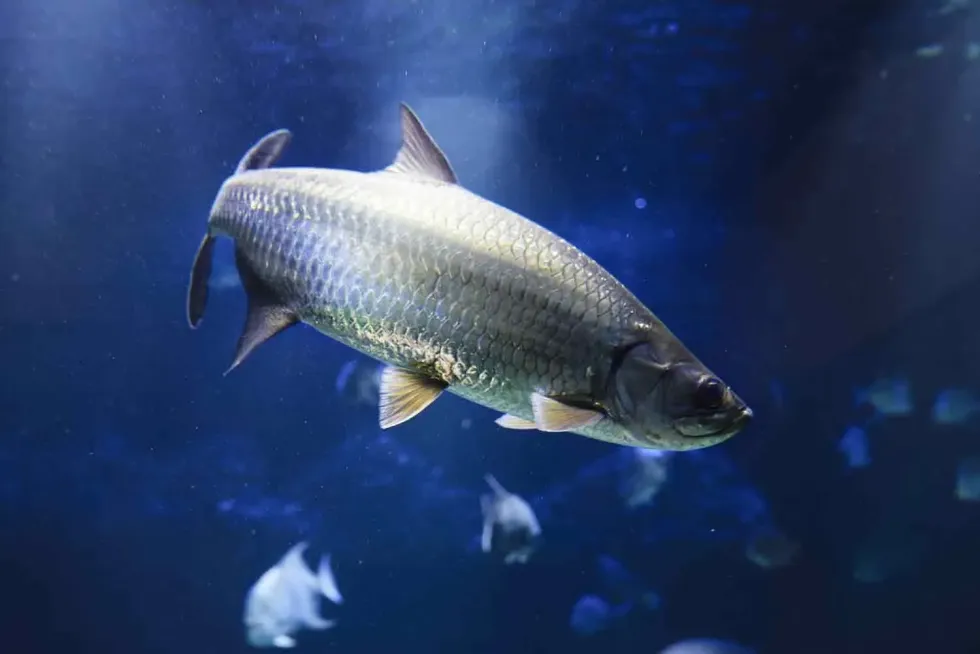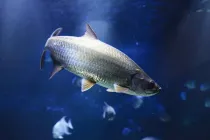Tarpon is a type of fish found in shallow coastal waters or estuaries. Tarpons are also known as the 'silver king' due to their majestic size and beautiful color.
Its body is covered with shiny silver scales and they have a blue or green body along with dorsal and anal soft rays.
Tarpons weigh around 60-280 lb (27-127 kg) and are 48-96 in (121-243 cm) in length. At the juvenile stage, tarpons feed only on zooplankton, but as they grow, they become better predators and prey on fish such as mullets and ladyfish
There are two species of tarpons: Atlantic tarpon (Megalops atlanticus) and Indo-Pacific tarpon (Megalops cyprinoides). Atlantic tarpon is found along the western (from Virginia to Central Brazil) and eastern Atlantic coast and Indo-Pacific tarpon live along the eastern African coast. They are also known to live in the Gulf of Mexico, West Indies, Florida, and the Caribbean Sea.
Even though tarpon doesn't have any food value, it is still caught by anglers in Florida to be used as a trophy but they have to pay a cost of 50 USD per tag, per fish, and without that tag, owning tarpon becomes illegal.
Here, we have a lot of amazing and interesting facts about the tarpon that you will enjoy. Let's take a look at these tarpon facts, and if you enjoy these then, do read our facts about barramundi and pumpkinseed sunfish.
Tarpon Interesting Facts
What type of animal is a tarpon?
Tarpon is a beautiful fish that has silvery scales on a large body, this earns it the title of 'silver king'.
What class of animal does a tarpon belong to?
Tarpon belongs to the Actinopterygii class. This class belongs to ray-finned fishes.
How many tarpons are there in the world?
The exact number of how many tarpon fish there are in the world is not confirmed as they're known to lay around 12 million eggs at once.
Where does a tarpon live?
Tarpons range from Virginia to Central Brazil. They are found in the Caribbean Sea, Gulf of Mexico and Florida. They are often caught by anglers in Nova Scotia and Bermuda, and south of Argentina.
What is a tarpon's habitat?
Tarpon habitat varies from estuaries to even freshwater rivers. It is known to live in lagoons, bays and shallow coastal waters. They can also live in areas that have poor oxygen levels as it has the ability to gulp air from the surface.
Who do tarpons live with?
Tarpons live and migrate in schools consisting of 25 to 200 individuals, and the size of the school increases when the new spawns join them after hatching. Large female tarpon fishes lay around 12 million eggs on average.
How long does a tarpon live?
Tarpon has a life expectancy of 55 years. The oldest male in the wild lived up to 55 years while a female lived up to 43 years. The oldest living Tarpon who was raised in captivity died at the age of 63 years.
How do they reproduce?
Tarpons have a very high reproductive rate. The school often swims offshore to warm and isolated areas in order to breed and lay eggs and the spawning occurs usually in late spring. Eggs hatch after two or three days.
What is their conservation status?
Tarpon is considered Vulnerable as its population is decreasing. The main causes behind this decrease in population are recreational harvest, habitat loss, fishing, and lowering of water quality.
Tarpon Fun Facts
What does a tarpon look like?
Tarpon has shiny, silvery scales all over its body except its head. It has large eyes with adipose eyelids, and it has a protruding lower jaw. Its anal fin is triangular and made up of 22 to 25 soft rays while its dorsal fin is made up of 13 to 15 soft rays.
How cute are they?
Tarpon is a very beautiful species of fish. Its shiny body attracts a lot of people and to some, it might appear cute. They're not just beautiful and cute, they are also good predators who have fine teeth and a bony plate in their lower jaw which makes them able to crush other animals.
How do they communicate?
Tarpons use thumping sounds that is created by their swim bladder in order to communicate with other tarpon fishes. They also use this thumping sound to warn other predators who are approaching them.
How big is a tarpon?
A tarpon is around 48-96 in (121-243 cm) in length and 12-19 in (30.5-48 cm) in height. When compared to crocodile, a tarpon is almost half the size and they often become prey to crocodiles. They're also smaller in size when compared to bull sharks and hammerhead sharks and become prey to these animals too.
How fast can a tarpon swim?
Tarpon comes in the ninth position in the world's top ten fastest fish. It can swim at a speed of 35 miles per hour (56 km/h) and is known for its incredible leaping ability. Apart from this, they have an incredible fighting spirit and attack their foe viciously.
How much does a tarpon weigh?
A Tarpon weighs around 60-280 lb (27-127 kg). They're average in size but are incredibly agile and fast swimmers that are known to have a great leaping ability.
What are the male and female names of the species?
The male and female species of tarpon do not have any specific names. They do share one common name, which is megalops.
What would you call a baby tarpon?
When the tarpon eggs hatch, they appear like transparent flat ribbons in their larval stage. At that stage, they are known as leptocephalus. A leptocephalus grows around to be 36-48 in (3-4 ft) long and has great mobility. They enter estuaries at night, in darkness, in order to hide from predators.
What do they eat?
At its juvenile stage, a tarpon is a planktivore. This means it eats small organisms such as zooplankton, insects, and small fish. At the adult stage, a tarpon diet consist of small fish and animals such as mullets, ladyfish and crabs. They become purely carnivores in their adult stage as they're also good predators.
Are they dangerous?
Tarpon usually get spooked around humans but in certain cases, they may accidentally injure anglers. This happens mostly when an angler is about to release the fish after catching it. There are also reports of tarpon killing anglers while fishing.
Would they make a good pet?
Tarpon requires a lot of space and food as a pet as they grow rapidly. it might grow about 39 in (1 m) in a few years if maintained properly, so they require space to swim properly and might also eat other fish in the aquarium.
Did you know...
Tarpon is considered to be one the best saltwater game fish. Tarpon fishing brings excitement and joy to fishermen as they're known to give a good fight and can perform amazing leaps. Although, their flesh is unwanted as it is bony and smelly and people avoid eating it. Tarpon fishing is a common sport played between fishermen in Florida.
Tarpon has also a modified swim bladder that enables it to survive in areas that have low oxygen levels. The swim bladder allows it to gulp air from the surface. The tarpon has a habit of gulping oxygen from the surface and they do it anyway, whether the area is rich in oxygen or not.
Do people eat tarpon?
People avoid eating tarpon as it is a bony and smelly fish that does not taste good. People head for tarpon fishing just for fun and once caught, they release the fish immediately from the hook and back into the water. Tarpon fishing is permitted only in Florida.
Differences And Similarities With Other Common Fish
Tarpon is considered to be a close relative of ladyfish. They both go through the leptocephalus larval stage after hatching. But while tarpon belongs to the Megalopidae family, ladyfish belong to the Elopidae family.
There are two species of tarpon in the world, Atlantic tarpon and Indo-Pacific tarpon, while ladyfish only has a single species. Both of them have small sandpaper-like teeth and swallow their food whole. Ladyfish have great value as food but tarpon as food is generally avoided.
Here at Kidadl, we have carefully created lots of interesting family-friendly animal facts for everyone to discover! Learn more about some other fish including codfish, or fluke fish.
You can even occupy yourself at home by drawing one on our Tarpon coloring pages.









